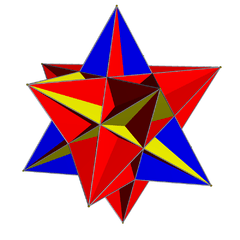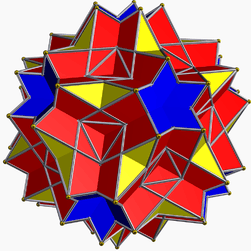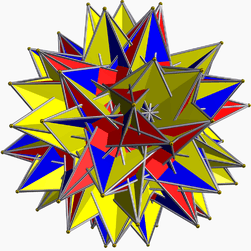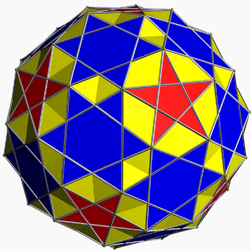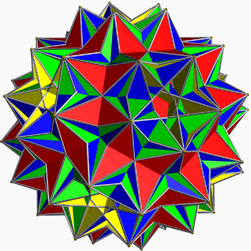Snub polyhedron
| Polyhedron | |
| Class | Number and properties |
|---|---|
| Platonic solids |
(5, convex, regular) |
| Archimedean solids |
(13, convex, uniform) |
| Kepler–Poinsot polyhedra |
(4, regular, non-convex) |
| Uniform polyhedra |
(75, uniform) |
| Prismatoid: prisms, antiprisms etc. |
(4 infinite uniform classes) |
| Polyhedra tilings | (11 regular, in the plane) |
| Quasi-regular polyhedra |
(8) |
| Johnson solids | (92, convex, non-uniform) |
| Pyramids and Bipyramids | (infinite) |
| Stellations | Stellations |
| Polyhedral compounds | (5 regular) |
| Deltahedra | (Deltahedra, equalatial triangle faces) |
| Snub polyhedra |
(12 uniform, not mirror image) |
| Zonohedron | (Zonohedra, faces have 180°symmetry) |
| Dual polyhedron | |
| Self-dual polyhedron | (infinite) |
| Catalan solid | (13, Archimedean dual) |
A snub polyhedron is a polyhedron obtained by adding extra triangles around each vertex.
Chiral snub polyhedra do not have reflection symmetry and hence have two enantiomorphous forms which are reflections of each other. Their symmetry groups are all point groups and are one of:
- O - chiral octahedral symmetry;the rotation group of the cube and octahedron; order 24.
- I - chiral icosahedral symmetry; the rotation group of the icosahedron and the dodecahedron; order 60.
For example, the snub cube:
 |
 |
Snub polyhedra have Wythoff symbol | p q r and by extension, vertex configuration 3.p.3.q.3.r.
List of snub polyhedra
Uniform
There are 12 uniform snub polyhedra, not including the icosahedron as a snub tetrahedron, the great icosahedron as a retrosnub tetrahedron and the great disnub dirhombidodecahedron, also known as Skilling's figure.
When the Schwarz triangle of the snub polyhedron is isosceles, the snub polyhedron is not chiral.
Notes:
- The icosahedron, snub cube and snub dodecahedron are the only three convex ones. They are obtained by snubification of the octahedron, cuboctahedron and the icosidodecahedron - the three convex quasiregular polyhedra.
- The only snub polyhedron with the chiral octahedral group of symmetries is the snub cube.
- Only the icosahedron and the great icosahedron are also regular polyhedra. They are also deltahedra.
- Only the first two and the last four also have reflective symmetries.
There is also the infinite set of antiprisms. They are formed from dihedra, degenerate regular polyhedra. Those up to hexagonal are listed below.
| Snub polyhedron | Image | Original polyhedron | Symmetry group |
|---|---|---|---|
| Tetrahedron | 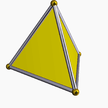 |
Digonal dihedron | Td |
| Octahedron |  |
Trigonal dihedron | Oh |
| Square antiprism |  |
Tetragonal dihedron | D4d |
| Pentagonal antiprism |  |
Pentagonal dihedron | D5d |
| Pentagrammic antiprism |  |
Pentagrammic dihedron | D5d |
| Pentagrammic crossed-antiprism |  |
Pentagrammic dihedron | D5d |
| Hexagonal antiprism |  |
Hexagonal dihedron | D6d |
Notes:
- Two of these polyhedra may be constructed from the first two snub polyhedra in the list starting with the icosahedron: the pentagonal antiprism is a parabidiminished icosahedron and a pentagrammic crossed-antiprism is a parabidiminished great icosahedron, also known as a parabireplenished great icosahedron.
Non-uniform
Two Johnson solids are snub polyhedra: the snub disphenoid and the snub square antiprism. Neither is chiral.
| Snub polyhedron | Image | Original polyhedron | Image | Symmetry group |
|---|---|---|---|---|
| Snub disphenoid | 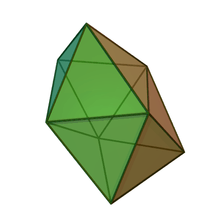 |
Disphenoid | 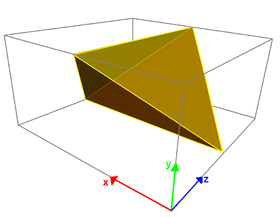 |
D2d |
| Snub square antiprism | 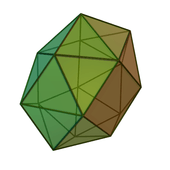 |
Square antiprism |  |
D4d |
Notes:
- Only the snub disphenoid is a deltahedron.
References
- Coxeter, Harold Scott MacDonald; Longuet-Higgins, M. S.; Miller, J. C. P. (1954), "Uniform polyhedra", Philosophical Transactions of the Royal Society of London. Series A. Mathematical and Physical Sciences 246: 401–450, doi:10.1098/rsta.1954.0003, ISSN 0080-4614, JSTOR 91532, MR 0062446
- Wenninger, Magnus (1974). Polyhedron Models. Cambridge University Press. ISBN 0-521-09859-9.
- Skilling, J. (1975), "The complete set of uniform polyhedra", Philosophical Transactions of the Royal Society of London. Series A. Mathematical and Physical Sciences 278: 111–135, doi:10.1098/rsta.1975.0022, ISSN 0080-4614, JSTOR 74475, MR 0365333
- Mäder, R. E. Uniform Polyhedra. Mathematica J. 3, 48-57, 1993.
| Seed |
Truncation |
Rectification |
Bitruncation |
Dual |
Expansion |
Omnitruncation |
Snub |
|---|---|---|---|---|---|---|---|
 |
 |
 |
 |
 |
 |
 |
 |
| t0{p,q} {p,q} |
t01{p,q} t{p,q} |
t1{p,q} r{p,q} |
t12{p,q} 2t{p,q} |
t2{p,q} 2r{p,q} |
t02{p,q} rr{p,q} |
t012{p,q} tr{p,q} |
ht012{p,q} sr{p,q} |


